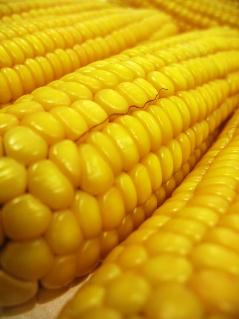In a recent conversation with one of the pioneers in the field, Roger Beachy, Ph.D., I learned a great deal about GMOs that I had never heard before. He used Bt corn as an example. It contains a protein from Bacillus thuringiensis (Bt) that can be found in soil anywhere in the world where there is agriculture. The bacteria that comprise this species make a lot of different kinds of proteins that kill a number of insects when the bacterium is ingested. For years, scientists tried to figure out how the proteins in the bacterium killed insects.
Organic farmers used it first, growing the whole bacteria in fermenters and drying it to a powder, which was dusted on vegetables so that the larvae wouldn’t destroy the leaves. Scientists in universities and in private companies took that concept one step further and identified the active ingredient; they then isolated a piece of DNA from the bacterium that made a protein that would kill specific pests that are a problem for corn growers. They injected that gene into cells of corn and the resulting GMO carried this protein in its leaves, so farmers didn’t have to dust crops a number of times during the growing season.
Also, remember that each protein is very specific and works only on those insects that have been targeted, not on the lady beetles, earthworms, nematodes, birds, or other animals that are considered beneficial. The resulting seeds that contain the Bt gene have been patented as new varieties and the farmer pays for that trait each time he buys that seed. His choice is to purchase spray for his crops or buy seed that is already bug resistant—a choice that is both less expensive and better for the environment because it only kills the targeted insects without affecting those organisms that are beneficial. It would seem to make business sense—and ecological sense, too.
According to Beachy, there are two primary issues with GMOs: the technology and the safety of the food produced. Volumes of research have been published on those issues, especially the food-safety aspect, which requires multiple trials. To ensure its safety, Bt corn and all other GMOs on the market have been tested on virtually every kind of livestock, birds and even earthworms. And remember, this is not a chemical, it’s a protein. Your body digests it just as you would soybean protein and it becomes part of your nutrition.
He continues to say that the supporting safety research on GMOs available today is so abundant and has been conducted over such a long period of time that the USDA now says that GMOs are “substantially equivalent” to the crops we started with and that’s why the United States doesn’t require they be labeled. Beachy said one more thing that really made me think: “I look at it this way: You either control the pests with genetics or you spray with chemicals. While the chemicals may be relatively safe, which is safer? If I have to choose between genetics and chemistry, I’ll come down on the side of genetics every time.”
As always, I’m not here to tell you what to think, but I do challenge you to bring this topic to your students and explore both sides of the issue. Are GMOs always bad—or always good? Are they safe? How can you tell if a product has been genetically modified? Can you tell by taste? Sight? Research can provide that information, and it’s a wonderful exercise in critical thinking for your students. Following are a few links representing both sides of the issue that you can use to begin your own research and debate with your students:
- Outreach Teaching Resources from Purdue University
- GMO FAQ from the University of Illinois
- Tomorrow’s Table: Organic Farming, Genetics, and the Future of Food by Pam Ronald and R.W. Adamchak, researchers at the University of California at Davis
- “Food Fight: The Case for Genetically Modified Food,” in the April 2011 issue of Scientific American
- GM Food Myths
- Genetically Modified Foods – Myth & Reality
- Public Views on GMOs – Deconstructing the Myths
- Busting Myths about GMOs
- Say No to GMOs
- Non-GMO Project
Christopher Koetke, CEC, CCE, is executive director of the Kendall College School of Culinary Arts and vice president of Laureate International Universities Center of Excellence in Culinary Arts. Kendall College sponsors the annual CAFÉ/Kendall College Green Award.
Photo: © Sergey Doronin | Dreamstime.com, http://www.dreamstime.com/stock-photo-texture-of-ears-of-corn-rimagefree3205528-resi1793763
 The truth about GMOs.
The truth about GMOs.